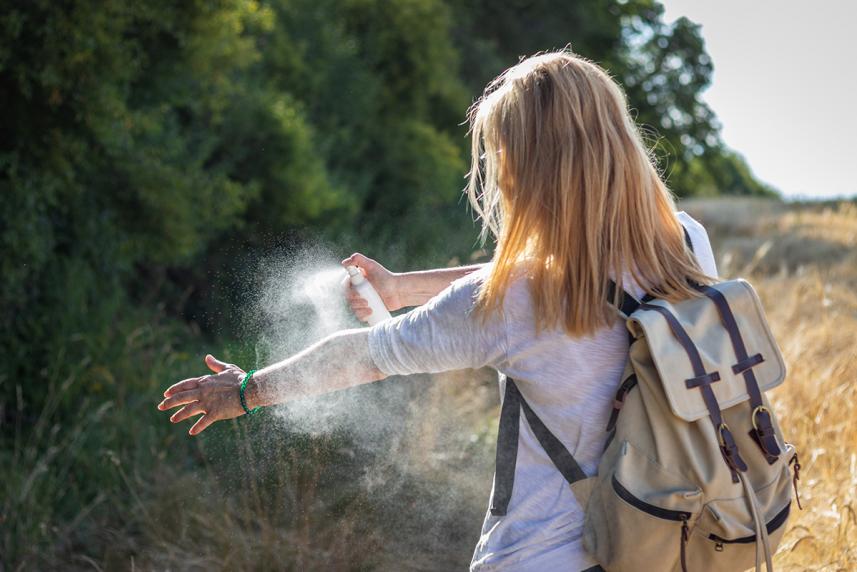
Summer bummers: 4 ways the season is hard on your skin

Learn how to treat (or avoid) poison ivy, mosquito bites, heat rash and blisters.
Summer is the best: sunny skies, days at the beach and tall glasses of ice-cold lemonade. But summer skin issues can take some of the fun out of the season. Here’s how to avoid the most common warm-weather itches, bites, rashes and blisters — and some tips for feeling better quickly if they happen anyway.
Summer bummer No. 1: Poison ivy
What it is: You’ve heard the rhyme “Leaves of three, let it be.” That’s good advice. But poison ivy (and its cousins, poison sumac and poison oak) grows just about everywhere in the U.S., so it can be hard to avoid. If you’re out hiking, camping or just working in the yard, there’s a good chance you’ll get exposed at some point. The leaves, stems and roots of the plant contain an oily resin called urushiol, which creates a rash when it brushes against your skin.
Signs and symptoms: You might not realize you’ve got poison ivy at first, until you start noticing the telltale signs — a red rash, swelling, itching and bumps. A mild poison ivy rash usually appears in a straight line, according to the Mayo Clinic.
How to avoid it: Wear long sleeves, long pants, boots and gloves. Try applying a thick skin ointment (such as Aquaphor) as a barrier. And if you’re using any tools, clean them with rubbing alcohol or soap and water while wearing disposable gloves. That’s important, because urushiol can stay active on surfaces for as long as 5 years.
You can spread the oil around your body or to others. You can also get the oil on your skin by laundering someone else’s clothes or even by touching a dog that has rolled in it. The resin even persists on dead leaves.
“That’s where the kicker is — this ability for the oil to rub off, including transferring to your sheets and spreading while you’re in bed,” says Britta Reierson, MD, medical director of Optum Everycare. Severe cases can even cause bacterial skin infections.
Quick tip: If you suspect you’ve touched poison ivy, wash the area as soon as possible to get rid of the oil. “Wash in one direction, not scrubbing back and forth,” says dermatologist Beth Goldstein, MD. She’s the president of Central Dermatology in Chapel Hill, North Carolina. This can help minimize the rash.
How to treat it: Early treatment is very important. Here’s what to do:
- Avoid scratching — and keep the area clean and dry.
- Apply an over-the-counter hydrocortisone cream or calamine lotion.
- Soak the affected area in cool water mixed with baking soda or an oatmeal-based bath product, or apply cool compresses.
If your case is severe, call your doctor, who can prescribe oral steroids.
Need a doctor? Schedule a virtual visit with one of our providers today — no insurance required. Get started.
Summer bummer No. 2: Mosquito bites
What it is: Nothing’s more annoying than the buzz — or bite — of a mosquito when you’re trying to drift off to sleep. And more than that, their bites can be dangerous. Mosquitoes are “getting scarier because of what they can carry,” says Dr. Reierson. That includes illnesses such as West Nile virus and La Crosse encephalitis.
Signs and symptoms: Look for a puffy, red bump shortly after you’ve been bitten. It can be itchy and may have multiple dark spots that look like bruises. Severe symptoms include a low-grade fever, hives or a large area of swelling and redness.
How to avoid it: The best tactic is to avoid mosquitoes: Stay away from standing water, cover up with long sleeves and pants, and use window screens and netting (don’t forget to protect baby strollers, too).
Use an insect spray that contains DEET. Spray clothing rather than skin after applying sunscreen, advises Dr. Goldstein. Be extra cautious when using insect spray on kids: Spray it on your hand first, then lightly rub it onto their face. Never use insect repellent on a child younger than 2 months of age.
How to treat it: If you do get a mosquito bite, use a little hydrocortisone cream to minimize the itching. Ice packs and topical solutions containing calamine also help.
For children who have a stronger reaction to bites, oral antihistamines can help. Adults can try antihistamines (such as Claritin and Zyrtec) too. Avoid scratching, which may lead to infection.
Summer bummer No. 3: Heat rash
What it is: Also known as miliaria or prickly heat, heat rash happens when your pores trap sweat under your skin. Some medications can also cause a reaction on your skin when you’re exposed to the sun after taking them. Common culprits include certain antibiotics, pain relievers and even birth control pills.
Signs and symptoms: You might have a rough red rash, small blisters or larger red lumps. Heat rash can be itchy, and sometimes blisters form, which may fill with a clear fluid and burst.
How to treat it: The solution is usually pretty simple, says Dr. Reierson. “You can help calm that reaction if you get out of the hot environment, cool yourself down and take a cool shower.”
How to avoid it: In hot weather, wear light, loose-fitting cotton clothing, which helps absorb moisture and keeps it off your skin. On very hot days, use air-conditioning or a fan to stay dry.
Summer bummer No. 4: Blisters
What it is: Summer can be hard on your feet. Watch out for foot and toe blisters — small, raised areas of skin filled with watery liquid. They’re caused by pressure, moisture and friction, which can happen when the outer layer of your skin rubs against your shoes or sandals.
Signs and symptoms: Look out for pockets of fluid that form on your skin after repeated rubbing, usually against a shoe that doesn’t fit well. Blisters can be painful, itchy and red.
How to treat it: The American Academy of Dermatology recommends these simple strategies:
- Cover the blister loosely with a padded bandage.
- Never pop a blister — that can cause an infection.
- When the liquid has drained from your blister, keep the area clean and add a bit of petroleum jelly.
- Don’t remove the roof of your blister — it helps protect your skin as it heals.
- Watch out for signs of infection. “If you start to get redness or a reaction around your blister, or if it starts draining an icky yellow fluid, see your doctor,” says Dr. Reierson.
How to avoid it: Try this dancer’s trick that works for the Radio City Rockettes: Tape areas of your feet and toes that might rub and cause blisters. Masking tape works great. And be sure to wear shoes that fill well.

Additional sources
Poison ivy: Mayo Clinic (n.d.). “Poison Ivy Rash”
Blisters: American Academy of Dermatology (n.d.). “How to Prevent and Treat Blisters”
